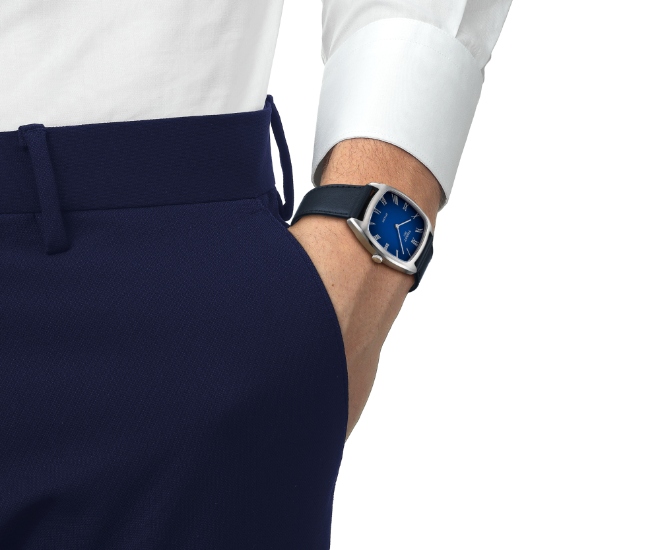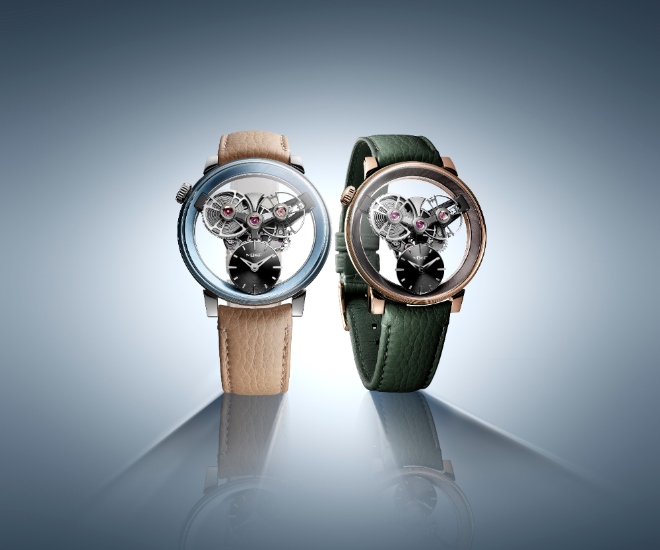
The phrase time flies has something to do with the speed with which time passes. Typically, this is only used when discussing how quickly time seems to pass when we are engaged in something fun. It is, to use the most relevant example, what magazine editors hope happens as you traipse across our pages. Happily, it is also relevant to the opening salvo of this potentially rambling missive. Ambling about in the Petit Palais in Paris, wine glass in hand while waiting for dinner to begin, I cannot help but consider how fast everything seems to be drawing to a close. Breguet has brought us all (that includes my co- pilot for this story, Ruckdee Chotjinda) to Paris for its first proper international launch in years, and certainly the first in the after-times. It has been a pastis-fuelled affair that has taken us across the city and its aerospace museum – for once, the museum visit here is not incidental but an integral part of the celebration…
We will come back to that museum, the Musée de l’air et de l’espace, briefly, but first I must return us to our narrative. We are assembled at the Petit Palais (the Grand Palais was under renovation during the launch in June and will be till next year) for the official launch of the Breguet Type 20 and Type XX, more specifically references 2057 and 2067, which happens to be one of the most significant chronograph-specific launches this year. As we mentioned in our Autumn issue, the watchmaking world is deep in the throes of a passionate love affair with the chronograph, and Breguet is hardly missing in action.
Having said that, this article warrants quite the introduction because Breguet has very specific reasons to celebrate the time-writer in 2023 and that has to do with accidents of history. Specifically, there is one connection in particular that is so fantastic that it could hardly be expected, yet it is a fact. More on that in a moment because there is a lot unpack here. Not for nothing, Breguet also has cause to celebrate because the two new references are really contemporary gems rather than tributes to the past. That alone would have warranted an extensive story such as this one.

As usual, this story will include the relevant history of Breguet, as far as it relates to the two new watches. History is of paramount importance in any issue that dares to label itself ‘Legacy’ after all. First though, this introduction concerns itself with several unique problems as far as the Breguet Type 20 is concerned… or is that the Type XX? As you can see, the first issue to resolve is the naming convention, for which we will rely on the official convention at Breguet, as noted on its website. The collection is called Type XX, although there was originally just one model called the Type 20, but that was a so-called mil-spec watch, made exclusively for the French Air Force. Confusingly, this model was known as both Type XX and Type 20 until 1955…
While that does settle things somewhat, you may be wondering what is going on here, especially if you are looking at Breguet with fresh eyes. And rightly so, but you will have to bear with us because the answer lies in the peculiar history of this most significant of chronographs. It is precisely that significance that is most problematic because of the power of the brand that is Breguet, and the legend that is its founder Abraham- Louis Breguet. This is the second year that Breguet has the cover of our Legacy issue, and it is quite possibly the brand most worthy of the legacy moniker. And yet, as we noted in our chronograph special last issue, that vaunted complication is not closely linked with either Breguet or its founder. We will eschew listing Abraham-Louis’ many accomplishments, but suffice to say that his spirit lives on in every watch with Breguet numerals, Breguet hands and, yes, every watch ever made that is endowed with a tourbillon. Not just every Breguet watch, but every watch.

The chronograph has an interesting story that is Abraham-Louis adjacent, shall we say, but that is neither here nor there. Yet, neither he nor his brand is responsible for it, nor the flyback function that defines an aviator’s watch such as the Type XX. Instead, it is a confluence of passions – for watchmaking and powered flight – that resulted in the collection we are examining. In fact, this collection is the tale of two Breguets, with one being the watchmaking brand we are all familiar with. The other one was called Breguet Aviation, and still exists today, as part of Dassault Aviation; Breguet Aviation was founded by Louis-Charles Breguet, the great-great-grandson of Abraham-Louis. This is extremely fitting, given that there are also two sides to Abraham-Louis – he was both a French watchmaker and a native of Neuchatel, who is today largely claimed by the Swiss while the brand that bears his name straddles both cultures. And on that note, let the history of the Type XX unfold…
Historical Landmarks
What did the French Air Force, the Aéronavale, otherwise known as the airborne wing of the French Navy, the French national airline Air France, the makers of the supersonic aircraft Concorde, and the Presidency of the French Republic have in common? If you are cheeky, you might say they are all French, except Concorde which was Anglo-French. Not to worry if this is you because we have you covered. What links all these entities is something they all bought: on-board chronographs and/ or chronograph wristwatches from the Breguet watch company, or they did before the advances of electronic instruments. In the case of the Elysees Palace, the purchases were intended as official gifts, not for technical use, but it is worth mentioning all the same.

The above speaks to Breguet’s intrinsic French character, but also to its aviation chops. To the contemporary world, Breguet may not be known as a producer of pilot watches or aviation-related instruments. This is unsurprising because the brand leans into its classical watchmaking roots, which, given the aforementioned legendary status of Abraham-Louis, is only logical. Hence, most watch enthusiasts are more familiar with the Tradition, Classique and Reine de Naples collections; Breguet even tells us that the Reine de Naples is a best-seller, which exposes our masculine biases and tells us that we need to pay closer attention. Anyway, these discreet yet characteristic timepieces are often seen gracing the wrists of collectors and socialites worldwide.
Breguet was, in fact, associated with the grittier and riskier world of aviation from its pioneering decades up until the 1980s. The firm’s famously detailed historical records show that their watches were sold to pilots of various backgrounds between the 1910s and 1920s, including one Alberto Santos-Dumont. Products with properties to withstand harsh conditions associated with the earlier days of flying and those with aviation-specific functionalities, such as the chronograph for essential in-flight timings, were subsequently introduced in the 1930s. From the 1910s onwards, this is where Breguet Aviation, known properly as Société d’Aviation Louis Breguet, comes into it.
Charles-Louis Breguet was active in the development of aircraft and helicopters during the two world wars and the ensuing decade. We saw real examples of his work at the aforementioned museum, and you can too, if you are so inclined. For the Breguet watch company, run from 1870 by former employee, Edward Brown and subsequently by his heirs, the very first chronograph wristwatches for pilots were documented in their sales records in April 1953 – the first watches sold that might have been used by aviators is another matter that requires more pages than we can spare.

The Type 20 in particular was designed to the specifications issued by the nascent French air force in the early 1950s. Said watch had to have a “black dial with luminescent numerals, luminescent hands, a high- quality movement resistant to changes in pressure and acceleration, a rotating bezel, and of course a “flyback” function…” according to the contemporary Breguet firm. This is confirmed by various other watch specialty titles, especially those that get into the Type XX aviator’s watch, but more on that below.
The resulting Breguet watch, in prototype form, was delivered to the Service Technique Aeronautique in 1952, and approved by the same in 1953. The production watch was referred to as Type 20 most of the time, but also Type XX on occasion; the ministry in charge of aviation (named the Ministry of Air, it is now defunct) actually named the watch the Type XX, when it issued the aforementioned specifications for it. Interestingly, the story of the Type XX is not limited to Breguet, with a number of storied names including Auricoste, Dodane, Matthey-Tissot and Vixa also supplying the French armed forces with watches of this type (no pun intended). The first notable aviator known to own a Breguet Type 20 was the pioneering test pilot Jacqueline Auriol – Charles-Louis Breguet presented this watch to Auriol himself.
Breguet appears to have led the pack, given the timing of the first prototypes as well as the first production models. Returning to the Type XX as made by Breguet, the firm reports that the naming irregularity between Type 20 and Type XX continued for a couple of years before a system was formally established in 1955, when watches being supplied to the Air Force would be marked with Arabic numerals and the ones for civilian customers would be marked with Roman numerals. Some 1,100 pieces were made, possibly making the Type XX the first serially produced chronograph for Breguet.
Incremental design improvements were introduced over time, with the chronograph minute counter being enlarged for extra legibility, or the additional 12-hour counter appearing at 6 o’clock on the civilian Type XX, for example. All of these watches produced until 1970 are classified as the first generation for the purpose of historical grouping. This also marked the end of the Brown family’s stewardship of the Breguet watchmaking firm and the start of the Chaumet family’s ownership of Breguet. The brothers moved the firm’s production to the Vallée du Joux later, and Swiss watchmaker Daniel Roth famously made his mark there.
The second generation Type XX ran from 1971 to 1986 during part of this era. However, the line went into hiatus for nine years, before returning as the third generation in 1995, now powered by Nouvelle Lemania movements. This was the era of Investcorp ownership of Breguet, and the private equity group had acquired the Lemania firm in 1992 to make the engines of Breguet watches. The Type XX watches of this time were called the Aéronavale 3800 and Transatlantique 3820 – they were versions without and with the date, respectively. Compared with the earlier generation, these new watches of the 1990s introduced major changes which included the use of a self-winding movement instead of a hand-winding one, and the Breguet signature fluting on the caseband. We believe many of our dear readers had an experience or at least an encounter with the third generation Type XX before it was overshadowed by the popularity of other Breguet collections.
One might think that Breguet has forsaken this utilitarian or sportive line of watches. This is not true. In 1999, Swatch Group took over from Investcorp and Breguet became the crown jewel of the late Nicholas G. Hayek. Hayek was amongst the leading lights of contemporary watchmaking, and set Breguet down the path of advancing traditional watchmaking, just as Abraham-Louis did. Though Breguet began, in this period, to reinforce its links with its founder (witness the Reine de Naples and Tradition, two collections inextricably tied to the image of the brand in the 21st century) but it did not simply ignore the Type XX. Indeed, this era saw the introduction of proper successors to the collection, with the debut of the Type XXI Reference 3810 and Type XXII Reference 3880. The later watch in particular is still cited widely for its maddening 10Hz escapement, which dazzled us at BaselWorld in 2010. While these watches now clearly belong to their own era, the Type XX collection moved into its current size of 42mm at this time.
Things have been a bit quiet since these developments but Breguet has hardly been idle; the watchmakers spent at least the last four years developing the fourth generation Type XX that launched in June this year.
Return To Form

Breguet made chronograph history with the launch of the Type 20 Chronographe 2057 and Type XX Chronographe 2067 in Paris recently. Let us reassure you that there really are two very different watches here; of course you could rely on just your eyes here but there are key details to consider, such as the bezel for one, which we will get to. A quick check on the Breguet website will show you that only the two most recent references remain in the collection. All chronograph lovers will also need to keep the price in mind because it is so significant that we are bringing it all the way forward in the narrative. Breguet says both references retail for USD 18,000 or USD 26,000, which makes this one of the best value propositions in prestige in-house Swiss Made chronographs in steel.
Breguet does not offer many chronographs, and the new Type XX models compare very favourably against the Marine 5527 (USD 36,000 in titanium), which uses a different movement besides. It might well be the most accessible Breguet model, which is consistent with the Type XX’s recent history within the collection. Both references 2057 and 2067 share the same case specifications, meaning both are 42mm in diameter and 14.1mm thick. It may be visible from these photographs that Breguet has chosen to go back to the original design without fluting on the caseband, in order to pay homage to the tool watch spirit. While the size may raise some eyebrows, the style of the lugs (now sculpted and altogether more elegant, again in keeping with a certain style of lug design not seen since before Reference 3800) keeps it wearable across a variety of wrist sizes. As plenty of other commentators have pointed out, the Type XX watches are pilot’s watches, and these tend to wear large.
Perhaps contentiously, both watches keep the date between 4- and 5 o’clock, which might be the least popular date positions as far as collectors are concerned. On that note though, this position has been chosen very deliberately, given that the Swiss Made mark is below the window. The movement was also not simply thrown together, with both calibres 728 and 7281 being integrated chronographs. We salute the manufacture for the courage of its convictions.
Aside from size and ergonomics, References 2057 and 2067 differ entirely, right down to the type of lume used and the style of hands. Where Reference 2057 features pencil hands and fresh green lume, Reference 2067 has lance hands and aged lume. The former is a bicompax chronograph (small seconds at 9 o’clock and 30-minute totaliser at 3 o’clock), the latter is tricompax (small seconds at 9 o’clock, 15-minute totaliser at 3 o’clock and 12-hour totaliser at 6 o’clock). The arrangement of subdials is indicative of the different movements here, calibre 7281 for reference 2057, and calibre 728 for reference 2067. In terms of substance, both calibres have a lot in common though, especially in the fast-beat (5 Hz) all high-tech silicon escapements (hairspring, anchor and escape wheel), and the 60-hour power reserve.
The two chronograph calibres are new, and are integrated rather than modular. In our original story on the Type XX watches, this was a mere supposition on our part, but we see that Breguet CEO Lionel a Marca has confirmed this (in comments to Revolution). For some context here, it would have been simpler for Breguet to use a base movement that it could mount slightly different chronograph modules on, but the brand rightly concluded that this would be decidedly unattractive for Breguet, given the history of the name. Thus we have two integrated chronograph movements that add to the value proposition of the Type XX collection.
Both calibres are distinguished by column wheels and vertical clutches; of course, this chronograph is of the flyback variety so that function is in the mix too. We published an extensive read on the chronograph in our last regular issue (#70) but, in short, the vertical clutch here means that the chronograph wheel, which must connect with the movement to get the chronograph going, is held above and away from the seconds wheel by a pair of clamps. These disengage when the chronograph is activated, dropping the chronograph wheel onto the cannon pinion that also holds the seconds wheel. In this way, the chronograph is driven by same force as the seconds wheel, without any meshing of gears.

In practice, you will not see anything much, which is a downside of the vertical clutch – the horizontal clutch offers far more visual spectacle – but there will be a real performance upside. Chronographs with vertical clutches can typically run without negatively impacting the amplitude of the balance, which is caused by the above-mentioned meshing of teeth. Dial-side, this typically means there will be no jerk or backlash when the sweep seconds hand starts.
As far as finishing goes, Breguet demonstrated how bevelling and other fine touches are done at the Paris launch (during the museum tour), without calling attention to anything that is done by hand in these new calibres. Nevertheless, we note that the finish is as good as anything at this level of fine watchmaking, including the aforementioned bevelling on the chronograph levers. Breguet collectors will note that the finishing here is much simpler than what one might expect for the Tradition and Classique collections, but again stand up quite well to what one will find in the Marine collection.
With regards to Reference 2057, the bidirectional rotating bezel is fluted and free of markings, except for the triangle at the top. The onion-shaped crown stays true to the original design of the military Type 20. One black calfskin leather strap and one black NATO fabric strap are provided. They are both designed with interchangeability in mind so you can swap them quickly without the need of a tool. The lugs are pretty standard, with spring bars and all, so other strap options are open too.

On the other hand, Reference 2067 follows the code established by a civilian Type XX watch of 1967. Here, it is interesting to note that the enlarged minute counter at three o’clock is graduated for 15 minutes (and not 30 minutes like most chronographs). This allows the minute chapters to be farther apart for easier reading, and there is the 12-hour counter at 6 o’clock to provide a longer overview of the timing session.
Note also how the main hour and minute hands are more triangular and reminiscent of the lances used by cavalry than Reference 2057 – this explains why watch enthusiasts everywhere call this type of hands “lance hands”; the lume is now in a shade of ivory. Other differences include the 12-hour graduation on the bezel and the straight-sided flat crown, which is the same design as the civilian Type XX back in those earliest days. Reference 2067 is worn on a brown calfskin leather strap and the extra NATO fabric strap comes in black, same as its sibling.
Both models are delivered in an interestingly designed box that resembles a vintage aircraft wing when viewed from the side. It comprises a leather flap atop a wooden structure. A built-in, internal slot provides practical storage for the strap not currently in use. For WOW, it is the perfect antidote to the trend where watch boxes are made of recycled or recyclable materials.
This article first appeared on WOW’s Legacy 2024 issue
For more on the latest in watch reads, click here.










